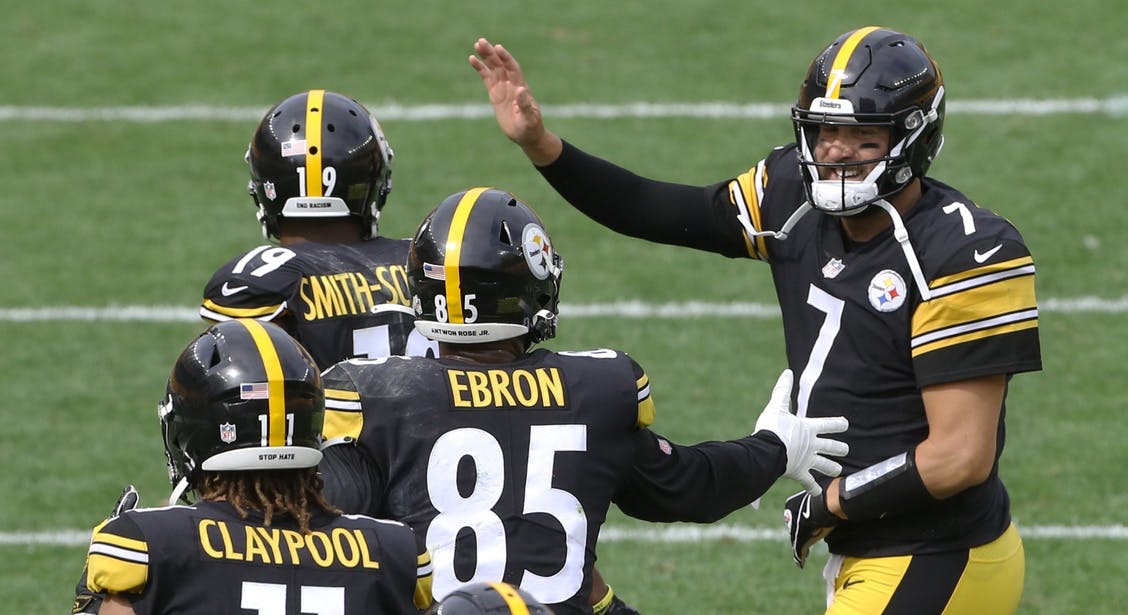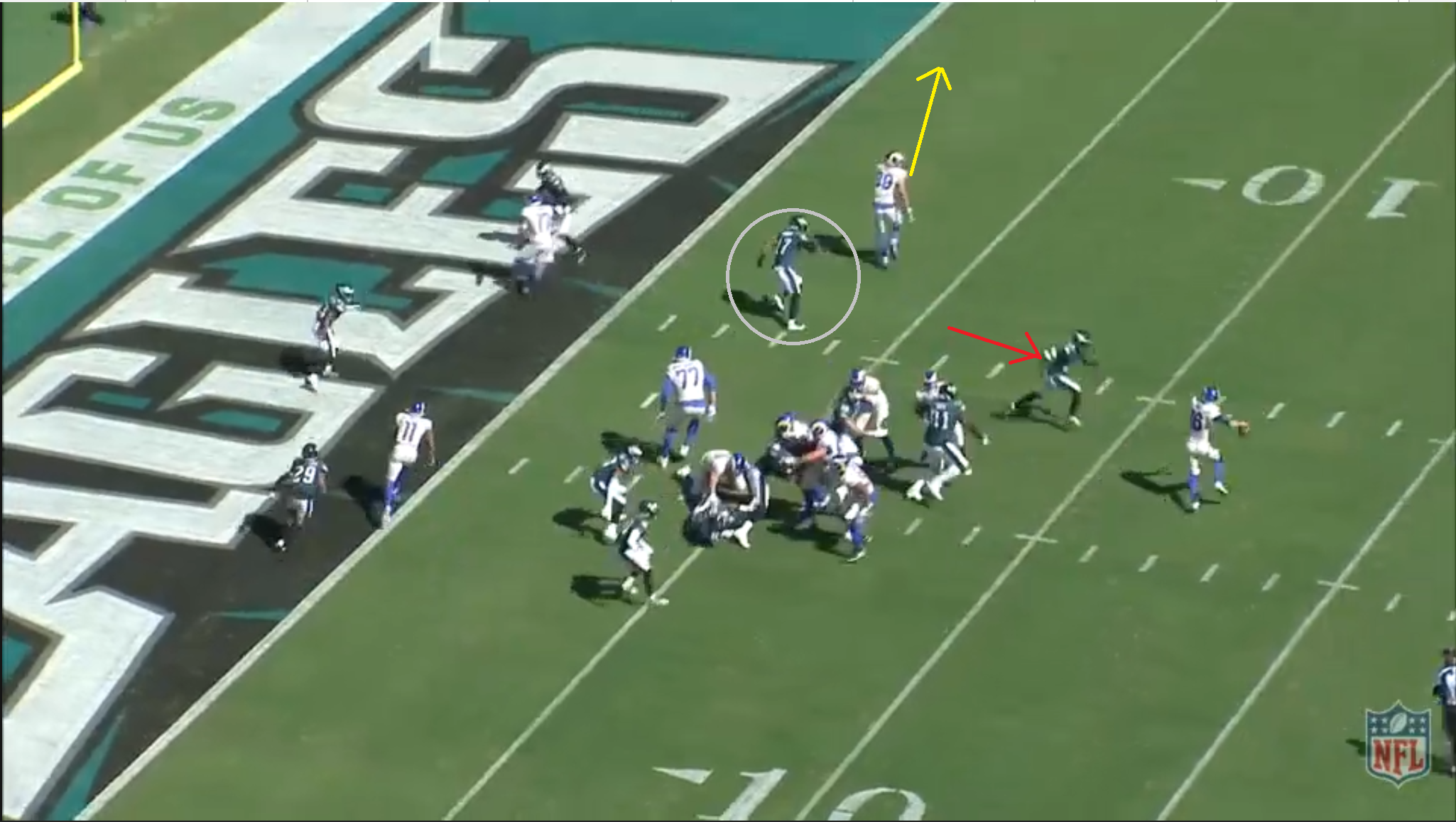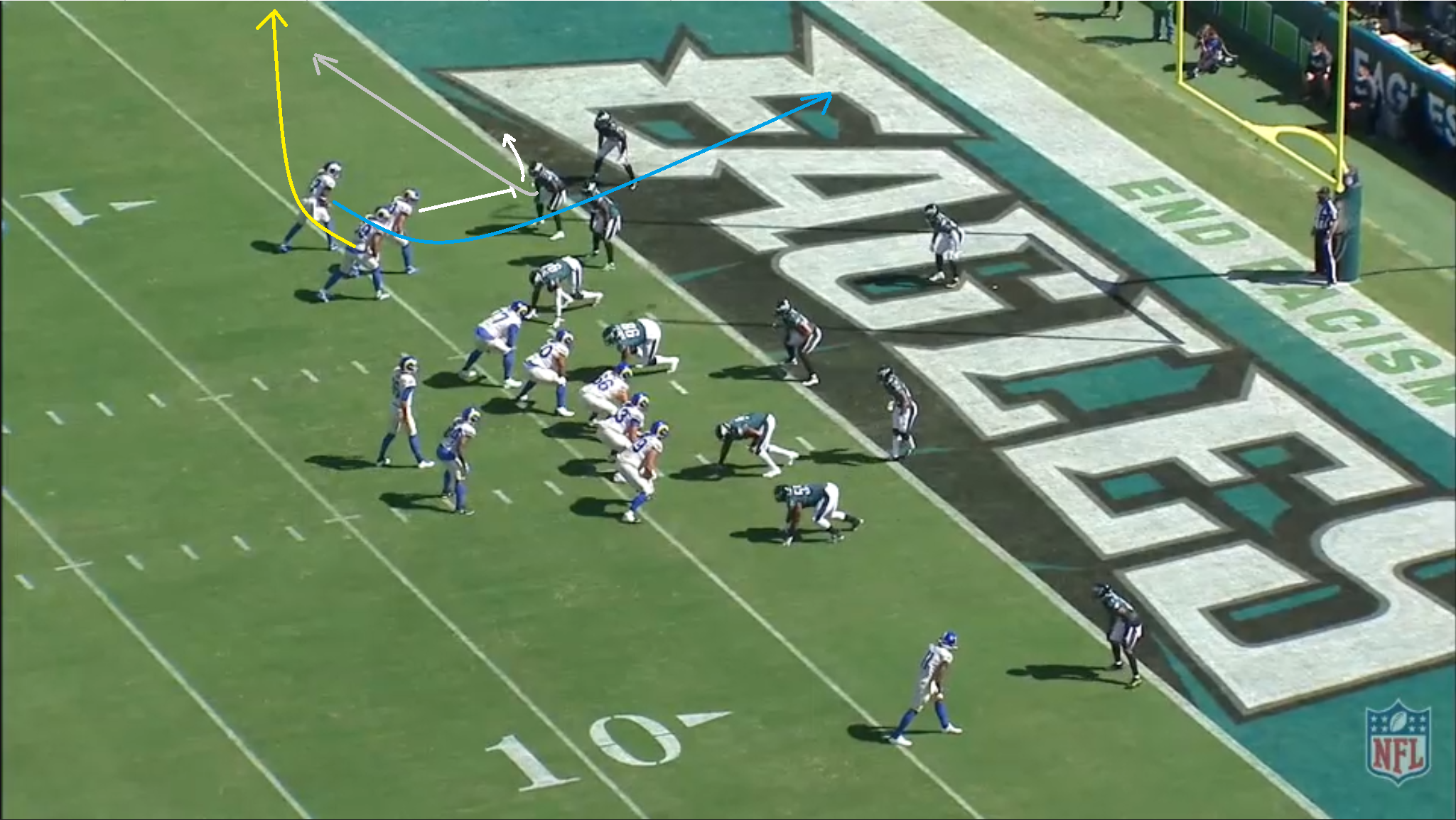The Philadelphia Eagles are 1-2-1 four games into the season, and somehow leading the dreadful NFC East. They come back to Pittsburgh for the first time since 2012. Earlier this week, I detailed how the Eagles “Wide-9” technique has caused problems for the Steelers in the past. The Eagles have a very good defensive line and lead the league in sacks with 17. Statistically, their pass defense has been around the league average. Defensively, Philadelphia ranks 17th in passing yards allowed and 13th in passing touchdowns allowed. However, of the 7 passing touchdowns allowed by the Eagles this season, FIVE have been to tight ends.
The best performance came last week when San Francisco’s George Kittle caught 15 passes for 183 yards and a touchdown. We should also not overlook the Rams’ Tyler Higbee who had 3 touchdowns in Week 2 against the Eagles. In Week 1, Washington’s Logan Thomas scored a 6-yard touchdown. Only the Bengals, who have basically no receiving tight ends, did not see success against Philadelphia. All told, Tight Ends have accounted for 20% of the targets against the Eagles defense (30 of 147) but account for 28% of the yards (276 of 974) and an incredible 71% of the touchdowns (5 of 7). Here is a look at each of the five touchdowns the Eagles have allowed to tight ends this season.
TD 1: Logan Thomas (Washington)
Situation: 3rd and 3 from PHI 6. 0:39 seconds left in the 2nd quarter
This was an absolute breakdown in coverage from Philadelphia. Logan Thomas is lined up in the slot on the left side of the line with Dontrelle Inman outside of him. Inman comes in motion before the snap, which causes the Eagles defense to react in two ways. The outside corner comes in motion with Inman, an indication of man-to-man defense. Additionally, the single-high safety crashes down into the box in the event of a jet sweep coming in his direction (both pre-snap movements shown in white below). This pre-snap movement creates a mis-match on the left side.
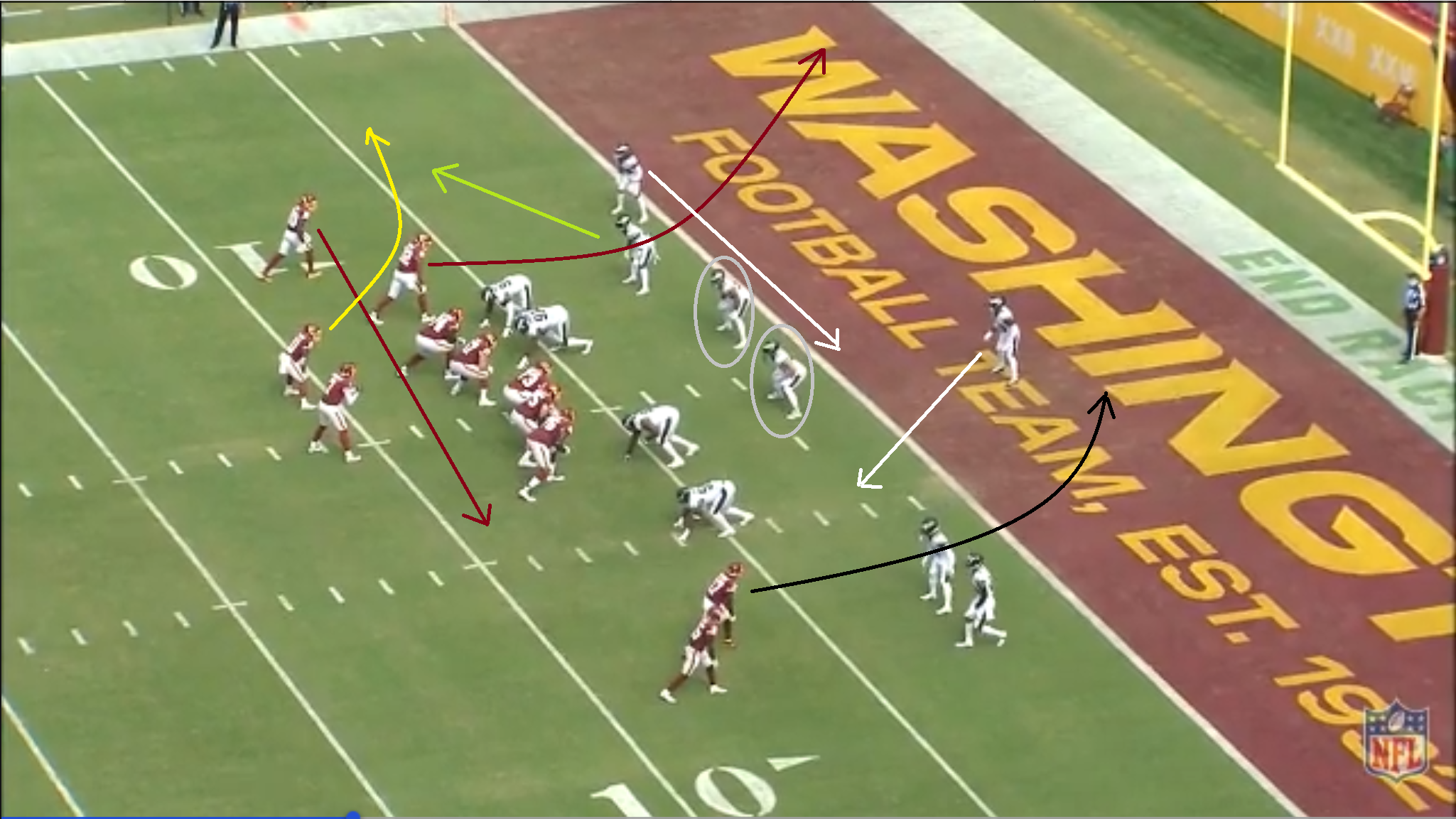 Thomas is running a simple post route while the running back is leaking out of the backfield behind him. Thomas runs right at Jalen Mills, forcing him to make a decision – either stick with Thomas and leave the running back wide open at the sticks for a first down or go after the running back. Mills goes after the running back (green line), leaving Thomas wide open in the end zone. The two middle linebackers (circled in grey) are frozen by the jet motion and do absolutely nothing on this play. Interestingly, on the back side Terry McLaurin was also open on a skinny post route out of the slot (shown in black). Here is the moment Haskins releases the ball:
Thomas is running a simple post route while the running back is leaking out of the backfield behind him. Thomas runs right at Jalen Mills, forcing him to make a decision – either stick with Thomas and leave the running back wide open at the sticks for a first down or go after the running back. Mills goes after the running back (green line), leaving Thomas wide open in the end zone. The two middle linebackers (circled in grey) are frozen by the jet motion and do absolutely nothing on this play. Interestingly, on the back side Terry McLaurin was also open on a skinny post route out of the slot (shown in black). Here is the moment Haskins releases the ball:
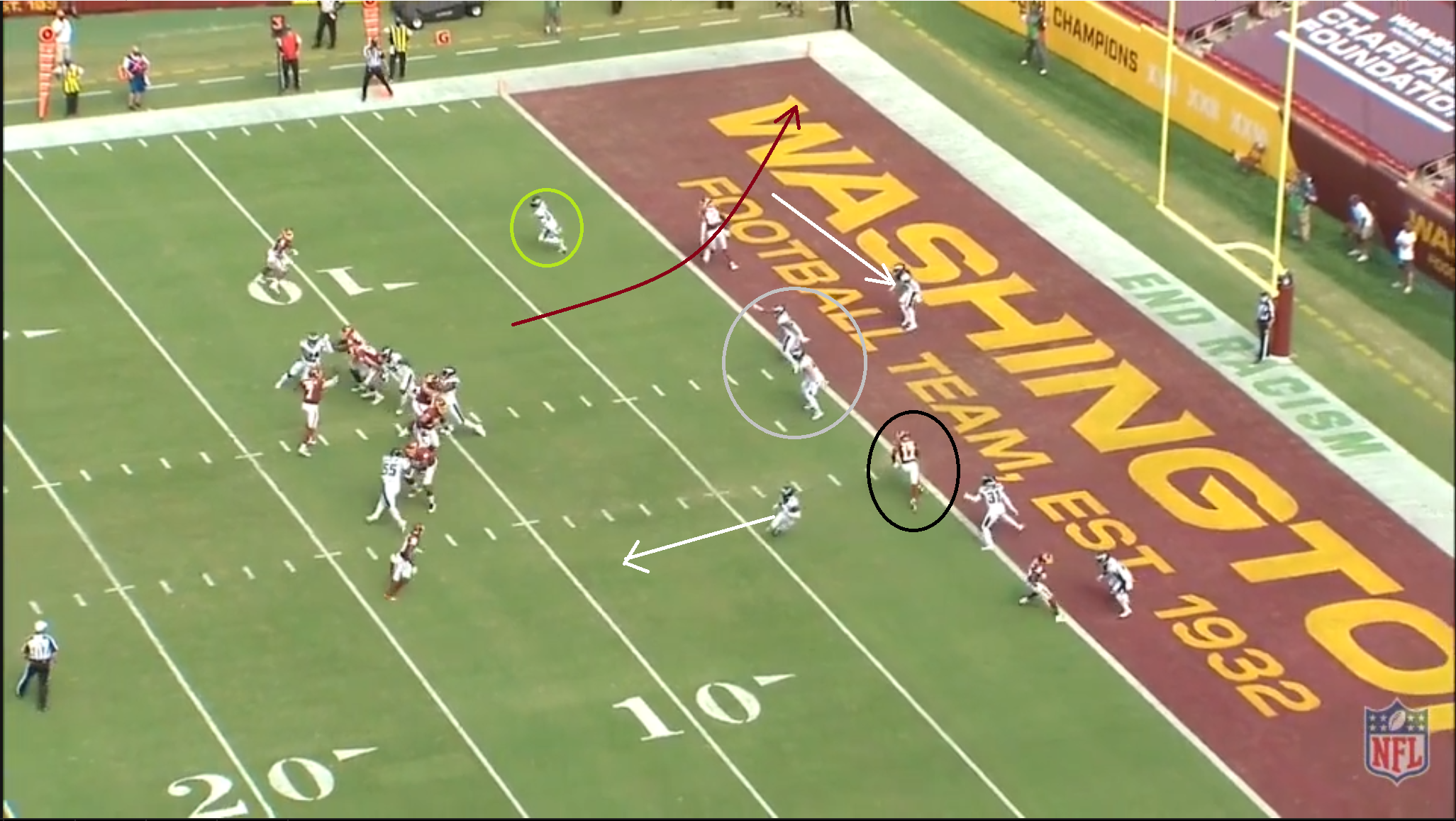 Mills (circled in green) is closing in on the running back and has released Thomas thinking someone behind him will pick up the TE. However, the outside corner had vacated his spot chasing the pre-snap motion and finds himself standing helplessly under the H in WASHINGTON while Thomas runs wide open to the corner. The two inside linebackers still haven’t moved. As I mentioned earlier, Terry McLaurin (circled in black) got open on his skinny post route at the goal line but that would’ve been a much tighter window to fit the ball into. This was an absolute coverage breakdown brought on by the pre-snap motion of the WR.
Mills (circled in green) is closing in on the running back and has released Thomas thinking someone behind him will pick up the TE. However, the outside corner had vacated his spot chasing the pre-snap motion and finds himself standing helplessly under the H in WASHINGTON while Thomas runs wide open to the corner. The two inside linebackers still haven’t moved. As I mentioned earlier, Terry McLaurin (circled in black) got open on his skinny post route at the goal line but that would’ve been a much tighter window to fit the ball into. This was an absolute coverage breakdown brought on by the pre-snap motion of the WR.
TD 2: Tyler Higbee (Los Angeles) #1
Situation: 2nd and 4 from PHI 4. 11:19 left in the 1st quarter
After Miles Sanders fumbled on Philadelphia’s opening drive, Jared Goff hit Cooper Kupp on a 3rd and 2 for 24 yards to get the Eagles inside the 10. After a first down run by Cam Akers got the Rams inside the 5, they went play-action and Goff found Higbee for the touchdown. The Rams used a two-TE set here with trips in tight to the right side. Gerald Everett (in white below), at the point of the trips, sold the play-action by blocking down on the defensive end. The corner read this and came on a blitz behind Everett to contain the backside (shown in red). Higbee (shown in yellow) slipped behind Everett and WR Robert Woods and had a wide open path to the pylon. 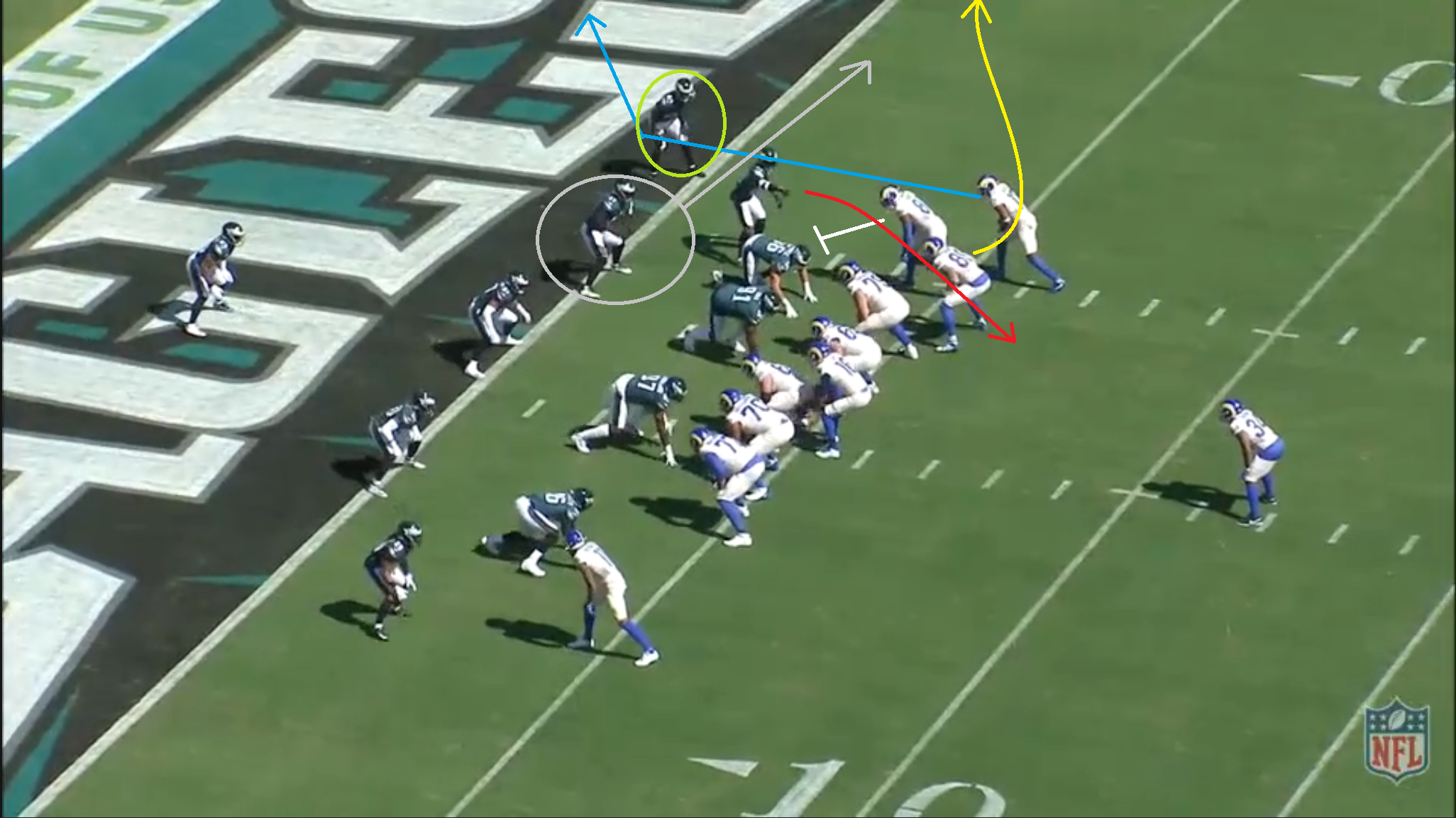 The Rams once again took advantage of LB Nathan Gerry (circled in grey). The Eagles are in a man defense and expecting a run. Robert Woods runs a post on the outside (in blue) and is covered tightly by the outside corner (circled in green). But with Higbee slipping around behind Everett and Woods, there is a lot of traffic for Gerry to work through. In live action, Gerry also pauses for a split second to eye up the play-action before trying to catch Higbee. At the moment of the throw, Gerry has no chance.
The Rams once again took advantage of LB Nathan Gerry (circled in grey). The Eagles are in a man defense and expecting a run. Robert Woods runs a post on the outside (in blue) and is covered tightly by the outside corner (circled in green). But with Higbee slipping around behind Everett and Woods, there is a lot of traffic for Gerry to work through. In live action, Gerry also pauses for a split second to eye up the play-action before trying to catch Higbee. At the moment of the throw, Gerry has no chance.
TD3: Tyler Higbee (Los Angeles) #2
Situation: 3rd and Goal at the PHI 3. 12:20 left in the 2nd quarter.
The Rams were up 14-3 at this point and using a no huddle to control the pace as they worked down the field. After getting to the line quickly, they lined up with trips to the left. This play design is relatively similar to the first that was run for a touchdown. There was no play-action or motion this time. Cooper Kupp (shown in white), at the point of the trips, got a slight pick against the corner, Nickell Robey-Coleman. Robert Woods is basically just running a clear-out route (shown in blue) to attract the attention of the defensive backs, who cover him well. Higbee, similar to the first TD, slips behind Kupp and Woods to make a run for the pylon. Robey-Coleman (shown in grey) has to fight through Kupp’s pick to get over and cover Higbee. He gets closer than Gerry did on the first touchdown, but Higbee fights through his tackle and extends the ball to the pylon for the touchdown.
TD4: Tyler Higbee (Los Angeles) #3
Situation: 2nd and 3 on PHI 28. 11:11 remaining in the 4th quarter.
This is the only tight end touchdown the Eagles have allowed from outside the red zone. There is no pre-snap motion, but the Rams come out in what looks like a run formation and go play-action. There are two tight ends (Everett and Higbee) stacked on the right side of the line. On the left side, Josh Reynolds is the flanker but lined up in tight with Robert Woods even closer in the slot. Overall, this is a well-designed play. After the snap, Woods (shown in light blue below) comes across the formation behind the line of scrimmage. Reynolds (in white below) is running a deep crossing route. Higbee (in yellow) is also running a crossing route to the other side (away from the play-action boot leg) that he turns upfield.
The Eagles outside corner and safety (circled in green) both move to follow Reynolds across the field. Given that this is also the direction Goff is rolling, the probabilities are with him throwing in that direction. However, this leaves LB Nathan Gerry (circled in grey, remember him from the first touchdown?) to try to run with Higbee across the field. He gets beat badly and Higbee is wide open for Goff to throw back across the field for a relatively easy touchdown. Here is the moment of the throw:
Goff throws the ball out to the goal line and lets Higbee just run underneath it and catch it in stride. Higbee is faster than Gerry and with that much room to run under the ball it’s about as easy of a pitch and catch as you’ll get in the NFL. The two defensive backs (circled in green) actually did a pretty good job of locking out Reynolds’ crossing route on this play, but it also left the back side of the defense completely exposed. The play-action froze the linebackers and Gerry just wasn’t fast enough to run with Higbee. Once again, we see the Eagles struggling to defend against play-action passes.
TD5: George Kittle (San Francisco)
Situation: 3rd and Goal from PHI 5. 8:30 remaining in the 3rd quarter.
George Kittle is one of the best tight ends in the league. He shredded the Eagles defense to the tune of 15 catches for 183 yards and a touchdown. On this play, the 49ers took advantage of the Eagles linebackers once again. The Rams victimized Nathan Gerry and here we see the 49ers going after Duke Riley. The route combination for the 49ers has the outside receiver running a simple out-route to clear out the boundary corner. Behind him, the running back leaks out of the backfield which draws the slot corner (circled in green). This leaves two defenders lined up on the hash marks, LB Duke Riley (circled in black) and S Marcus Epps (circled in grey) to try to cover George Kittle running a 7-route to the corner. 
As the play develops, Kittle easily wins the outside against Riley. Some blame here does lie with safety Marcus Epps. Rather than closing hard on Kittle, who is the deepest route to his side of the field, he pauses and points at Kittle. Granted, with the route Kittle was running it would have been difficult for Epps to close the distance and get over the top. Mullens’ pass is thrown out on the 49ers helmet towards the back line. Kittle makes a leaping grab over Riley, who was about as close as he could’ve hoped to be given his position to start the play.
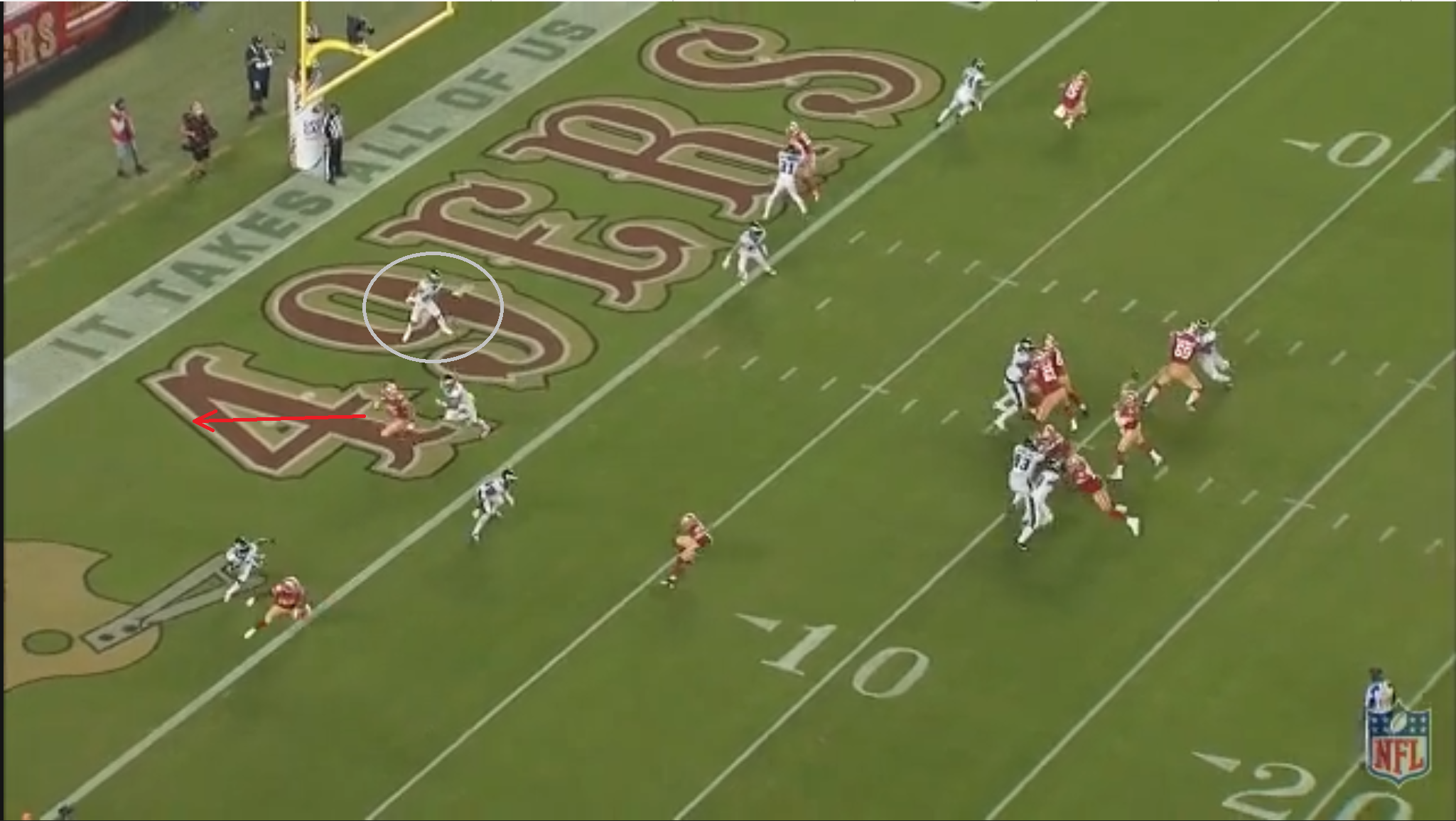 Part of this play is just George Kittle making a great play. Part of it is the Eagles defensive design where the slot corner covers down on the running back and lets Kittle run past him in the hopes that the inside defenders can cover him. Spoiler alert: they could not. Even for a backup quarterback like Mullens, this is a relatively easy throw to put the ball out on the helmet and let Kittle go get it.
Part of this play is just George Kittle making a great play. Part of it is the Eagles defensive design where the slot corner covers down on the running back and lets Kittle run past him in the hopes that the inside defenders can cover him. Spoiler alert: they could not. Even for a backup quarterback like Mullens, this is a relatively easy throw to put the ball out on the helmet and let Kittle go get it.
What Does This Mean For Pittsburgh?
There are some takeaways from these five touchdowns that the Eagles gave up to tight ends. They are susceptible to pre-snap motions and play-action passes. The play of their linebackers and safeties is absolutely dreadful. The Steelers have been using more pre-snap motion this season and should be able to exploit the linebackers with play-action passes. Additionally, Eric Ebron saw an increased role in the last game against Houston. Expect to see Ebron more involved in the passing game this week as the Steelers exploit the mis-matches against Riley and Gerry. Vance McDonald has had a quiet season so far but the Steelers may deploy a lot of two-tight end sets this week to exploit those matchups over the middle. The Eagles are banged up in the secondary and safety Jalen Mills has been playing corner because of a lack of healthy bodies. As long as the offensive line holds up, Ben Roethlisberger should be able to attack the Eagles coverages all over the field.

